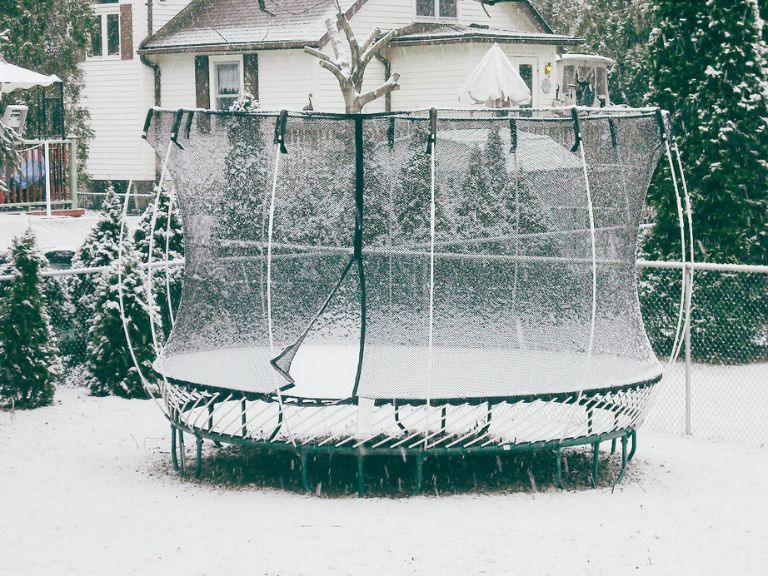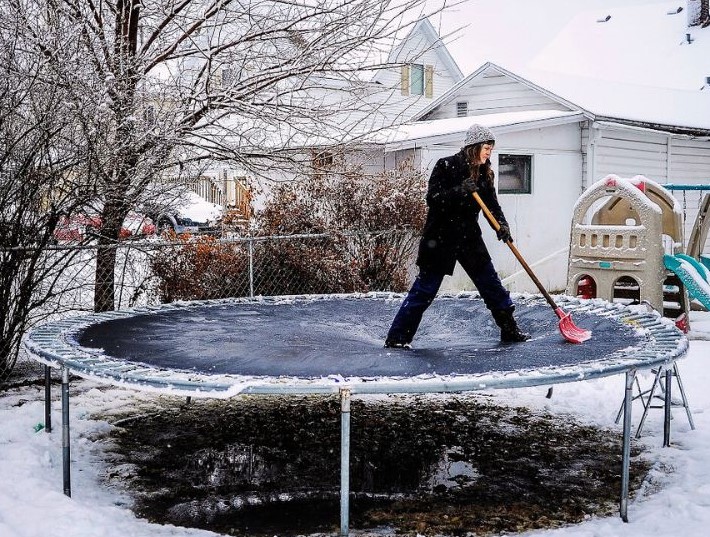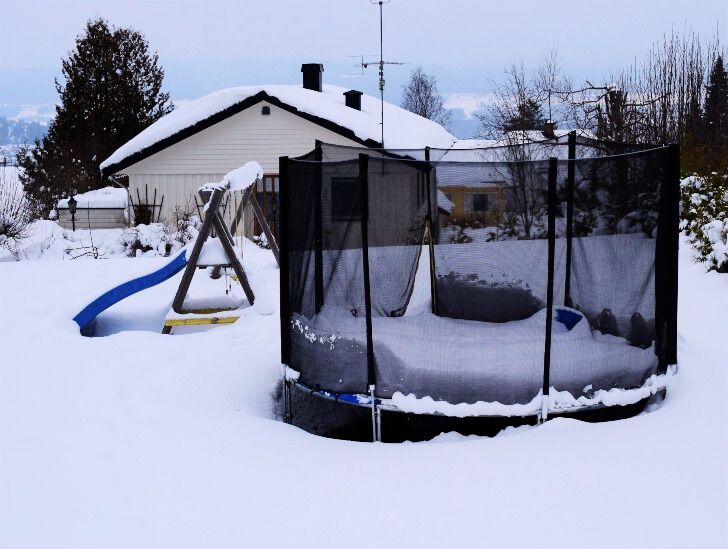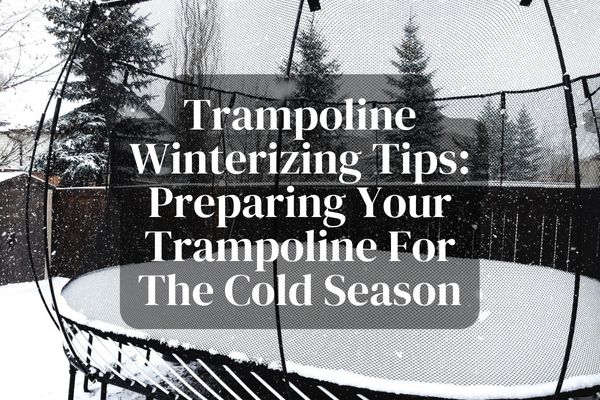As a trampoline owner, you’ve probably enjoyed hours of fun and entertainment bouncing around on your trampoline during the warmer months. But As the cold weather settles in, many trampoline owners wonder how they can continue to enjoy their favorite outdoor activity while ensuring their trampoline stays in top shape.
Winter brings unique challenges to trampoline owners, from freezing temperatures to snowfall, but that doesn’t mean you have to pack up your trampoline until spring arrives. By taking a few simple steps, you can protect your trampoline from harsh winter conditions and enjoy its benefits all year round.
From covering your trampoline to safeguarding the springs and frame, we’ll cover everything you need to know to keep your trampoline safe, durable, and ready for action.
Why Winterizing Your Trampoline is Important?
Winterizing your trampoline is important for several reasons.
- The colder weather can cause damage to the trampoline’s frame and springs, leading to rust and corrosion.
- Snow and ice can accumulate on the trampoline, putting excess weight on the frame and springs, which can cause them to bend or break.
- If you leave your trampoline out in the winter, it can become a safety hazard, as the surface can become slippery and dangerous to use.
Can a Trampoline Stay Out in the Winter?
While it is possible to leave your trampoline out in the winter, it is not recommended. As mentioned earlier, the cold weather, snow, and ice can cause damage to the trampoline, and it can become a safety hazard. It’s advisable to either disassemble the trampoline and store it indoors or cover it with a protective cover.
Affects of winter to your trampoline
How to Protect the Trampoline in Winter?
There are several ways to protect your trampoline during the winter months. The first step is to clean the trampoline thoroughly, removing any debris, dirt, or leaves. This will help prevent moisture from accumulating on the trampoline and causing damage. Once the trampoline is clean, you can either disassemble it and store it indoors or cover it with a protective cover.

Preparing Your Trampoline for Winter – Step-by-Step Guide
Here’s a comprehensive step-by-step guide to help you prepare your trampoline for the winter season:
Thoroughly clean your trampoline
Before winter sets in, give your trampoline a good cleaning. Remove any debris, leaves, or dirt that may have accumulated on the surface or in the frame. This step ensures that your trampoline is ready for storage or protected during the winter months.

Consider disassembling the trampoline
If you have sufficient indoor storage space, it’s highly recommended to disassemble your trampoline and store it indoors. Disassembling the trampoline not only protects it from the harsh winter elements but also helps prolong its lifespan. Store the disassembled parts in a dry and cool location, such as a garage or shed.
Explore alternative storage options
If you don’t have indoor storage space available, consider alternative options to protect your trampoline. Look for a dedicated outdoor trampoline cover designed to withstand winter weather conditions. These covers provide an extra layer of protection against snow, ice, and debris.
Secure the trampoline cover
When using a trampoline cover, make sure to secure it properly. Use bungee cords or sturdy ropes to fasten the cover tightly around the trampoline. This ensures that the cover remains in place even during strong winds or heavy snowfall.
Remove excess snow accumulation
If your trampoline gets covered in snow during the winter, it’s important to periodically remove the snow buildup. Excessive weight from snow can put stress on the trampoline’s frame and springs. Use a soft broom or brush to gently sweep off the snow, taking care not to damage the trampoline’s surface.
Essential Trampoline Winterizing Tips – Covering, Disassembling, Storing, etc.
Here are some essential trampoline winterizing tips to help you protect your investment:
Covering
- Use a protective cover specifically designed for trampolines.
- Secure the cover with bungee cords or rope to prevent it from coming off in windy conditions.
- Make sure the cover is tight to prevent moisture from accumulating on the trampoline.
Disassembling and Storing
- Disassemble the trampoline if you have the space to store it indoors.
- Store the trampoline in a dry, cool place to prevent rust and corrosion.
- Cover the trampoline with a protective cover to prevent dust from accumulating.
Snow and Ice Removal
- Remove snow and ice from the trampoline as soon as possible to prevent excess weight from accumulating on the frame and springs.
- Use a broom or soft-bristled brush to remove snow and ice. Do not use a shovel or any sharp objects, as they can damage the trampoline.
Tools and Supplies Needed for Trampoline Winterizing
Here are some tools and supplies you may need to winterize your trampoline:
- Protective cover
- Bungee cords or rope
- Soft-bristled brush or broom
- Lubricant spray
- Rust inhibitor spray
Common Mistakes to Avoid When Winterizing Your Trampoline
Preparing your trampoline for the winter season is crucial to protect its integrity and ensure a safe bouncing experience when spring arrives. However, it’s essential to be aware of the common mistakes that many trampoline owners make during the winterization process. By avoiding these pitfalls, you can ensure that your trampoline remains in excellent condition throughout the cold months:
Neglecting to Clean the Trampoline
One of the most common mistakes is failing to clean the trampoline before winterizing it. Leaves, debris, and dirt left on the trampoline’s surface can lead to mold growth and damage the mat and springs over time. Before proceeding with any winterization steps, thoroughly clean your trampoline using a soft brush or broom to remove all debris. This simple yet crucial step will ensure a clean and healthy trampoline when spring arrives.
Not Disassembling the Trampoline (If Possible)
Disassembling the trampoline is highly recommended if you have sufficient indoor storage space. Some trampoline owners make the mistake of leaving it fully assembled outdoors during winter. However, exposing your trampoline to harsh winter conditions can lead to rust, damage to the frame, and decreased overall lifespan. If you have the space, take the time to disassemble the trampoline and store it indoors in a dry and cool location, such as a garage or shed. This step provides optimal protection and preserves the trampoline’s quality for years to come.
Choosing an Improper or Poor-Quality Cover
Using a trampoline cover is an effective way to protect it from snow, ice, and debris during the winter season. However, another common mistake is selecting an improper or low-quality cover. Make sure to choose a cover specifically designed for trampolines and that it fits your trampoline’s size properly. Investing in a high-quality, weather-resistant cover will ensure maximum protection against the elements and prevent any potential damage to your trampoline.
Failing to Secure the Cover Adequately
Securing the trampoline cover is just as important as selecting the right one. Neglecting to secure the cover properly can result in it being blown away by strong winds or heavy snowfall, leaving your trampoline exposed and vulnerable. Use bungee cords or sturdy ropes to fasten the cover tightly around the trampoline, ensuring it remains securely in place. Regularly check the cover throughout the winter to ensure it hasn’t become loose or detached.
Forgetting to Remove Snow Buildup
During the winter months, snow can accumulate on your trampoline’s surface, putting excessive weight and strain on the frame and springs. Failing to remove the snow buildup is a common mistake that can lead to damage. Use a soft broom or brush to gently remove the snow from the trampoline’s surface, taking care not to apply too much force that could cause damage. Regularly monitor the trampoline after snowfall and promptly remove any accumulated snow.

Trampoline Maintenance During Winter
While you may not be using your trampoline during the winter months, it’s still important to perform some basic maintenance to ensure that it remains in good condition. Here are some tips for trampoline maintenance during winter:
- Check the trampoline regularly for any signs of damage or wear.
- Remove any debris or leaves that may accumulate on the trampoline.
- Lubricate the springs and frame with a lubricant spray to prevent rust and corrosion.
- Apply a rust inhibitor spray to the frame and springs to prevent rust and corrosion.
Benefits of Winterizing Your Trampoline
Winterizing your trampoline has several benefits, including:
- Protecting your investment from damage caused by the cold weather, snow, and ice.
- Ensuring that your trampoline remains safe to use when the weather warms up again.
- Extending the lifespan of your trampoline by preventing rust and corrosion.
Trampoline Safety Tips During Winter
If you choose to leave your trampoline out in the winter, take some safety precautions to ensure that it remains safe to use. Here are some trampoline safety tips during winter:
- Do not use the trampoline if it is covered in snow or ice.
- Do not jump on the trampoline if the surface is slippery.
- Check the trampoline regularly for any signs of damage or wear.
- Do not attempt to disassemble or move the trampoline during icy or snowy conditions.
Trampoline Winter Storage
Conclusion
Winter doesn’t have to be the end of your trampoline fun. By following the proper steps to winterize your trampoline, you can ensure its longevity, safety, and performance. Remember to thoroughly clean the trampoline, consider disassembling and storing it indoors if possible, or use a high-quality trampoline cover designed to withstand winter conditions. Secure the cover tightly and regularly remove any snow buildup to prevent damage.
Taking these precautions will help protect your trampoline from the harsh elements, allowing you to continue enjoying it throughout the winter season.
Frequently Asked Question
Can I leave my trampoline assembled outside during winter?
Leaving your trampoline assembled outside during winter is not recommended. Exposure to harsh winter conditions can lead to rust, damage to the frame, and decreased overall lifespan. It’s best to disassemble and store your trampoline indoors, if possible, or use a high-quality trampoline cover for protection.
How often should I remove snow from my trampoline?
It is advisable to regularly remove snow buildup from your trampoline during the winter season. Excessive snow accumulation adds weight and strain to the frame and springs, potentially causing damage. Use a soft broom or brush to gently remove the snow, being careful not to apply excessive force that could harm the trampoline’s surface.
Can I use a regular cover to protect my trampoline during winter?
It’s recommended to use a cover specifically designed for trampolines to ensure optimal protection during winter. Regular covers may not provide the necessary durability and weather resistance required to safeguard your trampoline from snow, ice, and other winter elements. Invest in a high-quality trampoline cover for reliable winter protection.
How tight should the trampoline cover be secured?
When securing the trampoline cover, it should be tight enough to stay in place, even during strong winds or heavy snowfall. Use bungee cords or sturdy ropes to fasten the cover tightly around the trampoline. Regularly check the cover throughout the winter to ensure it remains securely fastened and hasn’t become loose or detached.
Can I use a tarp instead of a trampoline cover for winter protection?
While a tarp may provide temporary protection, it’s not ideal for long-term winterization of your trampoline. Tarps are often not designed specifically for trampolines, and they may not fit properly or provide adequate weather resistance. Investing in a trampoline cover specifically designed for winter use is recommended for optimal protection and durability.
Last Updated on September 28, 2023

